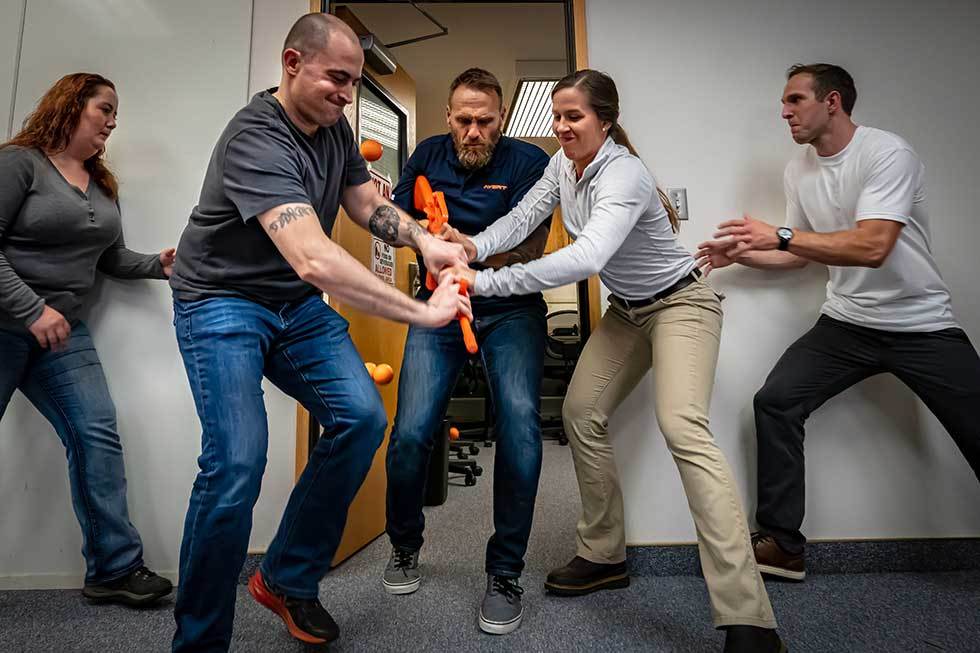How Active Shooter Training Can Save Lives in Dilemma Situations
Carrying Out Active Shooter Training: Ideal Practices for Producing a Safe and Prepared Neighborhood Atmosphere
As communities challenge the disturbing fact of active shooter events, the execution of comprehensive training programs becomes essential. A successful method depends upon not only the development of customized curricula that attend to neighborhood dangers but additionally the involvement of varied stakeholders. By using a range of training approaches, neighborhoods can ensure that all members are equipped with necessary skills. The challenge exists in keeping a flexible framework that advances with arising dangers. What are the crucial components that can change a conventional training program right into a durable version for community strength?

Understanding the Need for Educating
In an era marked by increasing occurrences of violence in public spaces, understanding the need for energetic shooter training has never been a lot more important. Detailed training initiatives can gear up individuals with the understanding and skills to react emphatically.
Training promotes a sense of empowerment and readiness, allowing individuals to feel more protected in their environments. The advantages of energetic shooter training expand beyond instant feedback; they include improving interaction procedures and boosting overall safety procedures within organizations.
Secret Parts of Effective Programs
Reliable active shooter training programs incorporate numerous vital parts that boost preparedness and reaction capacities. First, detailed curriculum advancement is crucial, guaranteeing that training material matters, evidence-based, and customized to the details demands of the organization or community. This consists of understanding the dynamics of active shooter events and the mental effect on individuals involved.
Second, practical training scenarios need to be utilized to imitate prospective scenarios, enabling individuals to exercise decision-making and action strategies in a regulated setting. These drills assist in muscle mass memory and build self-confidence among participants.
Third, an emphasis on communication methods is critical. Establishing clear lines of interaction among police, emergency situation responders, and individuals makes certain collaborated reactions throughout a case. Regular updates and correspondence course help maintain communication pathways clear and effective.
4th, continuous evaluation and responses mechanisms should be integrated into the training program - active shooter training. Analyzing the efficiency of training via individual responses and performance metrics allows for continual improvement
Lastly, fostering a society of safety and readiness within the neighborhood motivates vigilance and proactive actions, ensuring that individuals are not only experienced but additionally taken part in keeping a safe environment.
Engaging Neighborhood Stakeholders

To efficiently engage these stakeholders, it is vital to interact the objectives and benefits of the training. Hosting educational sessions can help clarify the training's function, address worries, and describe the duties each stakeholder may play. Furthermore, creating a stakeholder consultatory committee can assist in continuous discussion, allowing for diverse perspectives and insights to be integrated right into the training program.
Building connections with community leaders and companies is likewise critical. Their assistance can enhance outreach efforts, rise engagement, and make certain that training is tailored to the anonymous unique needs of the neighborhood. Continued In addition, stakeholders can help in sharing details and sources, reinforcing the message of safety and preparedness.
Eventually, engaging neighborhood stakeholders not just strengthens the training initiative yet additionally cultivates a feeling of possession among homeowners, bring about a much more resilient and informed area with the ability of reacting successfully to prospective risks.
Educating Delivery Methods
Using a range of training shipment approaches is vital to accommodate the varied understanding designs and demands of individuals in active shooter training programs (active shooter training). Efficient training can take several types, including lectures, hands-on simulations, on-line modules, and interactive workshops. Each method offers an one-of-a-kind function and can improve the general learning experience

On-line modules supply versatility and accessibility, enabling participants to discover at their very own speed. These can include video clips, tests, and discussions to gauge understanding. Interactive workshops urge team discussions and analytical, advertising synergy and communication abilities.
Integrating a combined technique that integrates these techniques not only improves the training experience but additionally her explanation makes certain that individuals are better prepared to respond successfully in the occasion of an active shooter scenario (active shooter training). By dealing with numerous discovering choices, companies can produce an extra educated and receptive area
Constant Analysis and Enhancement
Routine assessment and enhancement of active shooter training programs are critical to keeping their relevance and performance. As hazards evolve, so need to the methods and approaches employed in training. Constant examination guarantees that training content shows the most up to date intelligence on active shooter cases, including lessons learned from recent events and readjusting for arising patterns.
To promote this process, organizations ought to establish responses systems that include participant examinations, expert evaluations, and event debriefs. Gathering data on participant performance throughout drills and workouts is essential, as it highlights locations requiring renovation and notifies future training sessions. Additionally, involving with legislation enforcement and emergency responders can offer important insights into the functionality and applicability of training procedures.
Frequently set up reviews of training products and strategies must be mandated, fostering an atmosphere of development and versatility. Organizations should also urge a culture of recurring knowing, where personnel really feel empowered to recommend changes based on their experiences. By devoting to constant examination and enhancement, companies not only improve the effectiveness of their active shooter training programs yet also strengthen their total commitment to safety and security and preparedness within the neighborhood.
Conclusion
In conclusion, efficient application of energetic shooter training necessitates an extensive strategy that focuses on area engagement and realistic simulations. By developing tailored curricula, integrating varied training techniques, and cultivating cooperation among stakeholders, areas can enhance preparedness. Constant analysis and feedback mechanisms are essential for adjusting programs to emerging risks, consequently reinforcing overall security. Ultimately, a commitment to ongoing training and enhancement grows a society of alertness and readiness, making sure a safer environment for all community members.